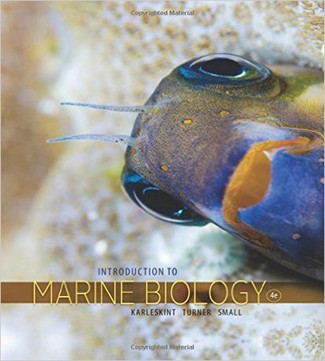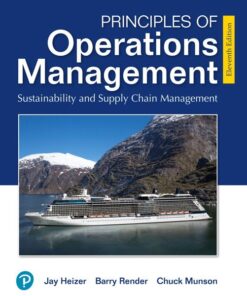Introduction to Marine Biology 4th Edition Karleskint Turner Small Test Bank
$35.00
Introduction to Marine Biology 4th Edition Karleskint Turner Small Test Bank
978-1133364467
Chapter 4—Water, Waves, and Tides
MULTIPLE CHOICE
1. Marine organisms contain ____ % water by mass.
a. 40-50
b. 50-60
c. 60-70
d. 70-80
e. 80-90
ANS: D PTS: 1 DIF: Recall REF: 67
2. Water can mingle with other elements because it is a:
a. heating agent.
b. solvent.
c. solid.
d. vapor.
e. nonpolar molecule.
ANS: B PTS: 1 DIF: Recall REF: 67
3. The charge of a water molecule is considered:
a. polar.
b. positive.
c. negative.
d. neutral.
e. nonpolar.
ANS: A PTS: 1 DIF: Recall REF: 67
4. The polarity of a water molecule is due to:
a. the greater number of hydrogen atoms relative to oxygen.
b. the uneven attraction of electrons to the oxygen atom.
c. the uneven attraction of electrons to the hydrogen atoms.
d. the uneven attraction of protons to the oxygen atom.
e. the number of neutrons in the nucleus.
ANS: B PTS: 1 DIF: Recall REF: 67
5. The unique attractive forces that keep molecules of water together are called:
a. strong forces.
b. adhesion.
c. hydrogen bonds.
d. cohesion.
e. weak nuclear forces.
ANS: C PTS: 1 DIF: Recall REF: 68
6. Hydrogen bonds are the result of attraction between:
a. the H of one water molecule and the H of another water molecule.
b. the two H atoms of the same water molecule.
c. the H and O of the same water molecule.
d. the H of one water molecule and the O of another water molecule.
ANS: D PTS: 1 DIF: Recall REF: 68
7. The property of water whereby molecules tend to stick to one another is called:
a. cohesion.
b. polarity.
c. dissolving ability.
d. adhesion.
e. viscosity.
ANS: A PTS: 1 DIF: Recall REF: 69
8. The property of water whereby molecules tend to stick to objects is called:
a. cohesion.
b. surface tension.
c. dissolving ability.
d. adhesion.
e. viscosity.
ANS: D PTS: 1 DIF: Recall REF: 69
9. Surface tension allows water molecules to do all the following except:
a. transmit light energy.
b. resist evaporation.
c. form a tight surface layer.
d. support small organisms.
ANS: A PTS: 1 DIF: Synthesis REF: 69-70
10. Hydrogen forces have high attractive forces that allow water to have a high:
a. strength.
b. solubility.
c. freezing point.
d. boiling point.
e. rate of evaporation.
ANS: D PTS: 1 DIF: Recall REF: 68
11. Water is unique because its solid phase is ____ the liquid phase.
a. denser than
b. similar to
c. less dense than
ANS: C PTS: 1 DIF: Recall REF: 68
12. An ion is:
a. a type of gas.
b. an individually charged particle.
c. heavy water.
d. water with an extra hydrogen atom.
e. a neutrally-charged atom.
ANS: B PTS: 1 DIF: Recall REF: 69
13. The specific heat of water is
a. a gram of substance.
b. energy required to raise a gram of substance 1? F.
c. calories need to heat seawater.
d. energy required to raise a gram of substance 1? C.
e. energy required to evaporate 1 gram of liquid water.
ANS: D PTS: 1 DIF: Recall REF: 69
14. Which low energy light wave length is quickly absorbed by water?
a. Red
b. Orange
c. Yellow
d. Green
e. a, b, and c above
ANS: E PTS: 1 DIF: Recall REF: 70
15. Which high energy light wave length can penetrate sea water the deepest?
a. Blue
b. Green
c. Violet
d. Red
e. a, b, and c above
ANS: E PTS: 1 DIF: Recall REF: 70
16. In most clear waters, 1% of surface light can penetrate to:
a. 10 m.
b. 20 m.
c. 50 m.
d. 75 m.
e. 100 m.
ANS: E PTS: 1 DIF: Recall REF: 70
17. You are SCUBA diving with a friend, who is wearing a red and purple wetsuit. You both descend and conduct your underwater research at 30 m. What color(s) does her wetsuit appear at this depth?
a. black and dark blue.
b. dark blue and purple.
c. dark green and black.
d. dark red and black.
ANS: A PTS: 1 DIF: Application REF: 70
18. Light that is absorbed by water is converted to:
a. short wave radiation.
b. long wave radiation.
c. heat.
d. mass.
e. green light.
ANS: C PTS: 1 DIF: Recall REF: 70
19. Acids are compounds that:
a. can bind hydrogen ions.
b. can release hydrogen ions.
c. are pH 8 or above.
d. contain hydrogen and hydroxide ions equal in number.
e. raise pH.
ANS: B PTS: 1 DIF: Recall REF: 70
20. Bases are compounds that do all the following except
a. they bind hydrogen ions.
b. they release hydrogen ions.
c. they are pH 7 or above.
d. they contain more hydroxide ions than hydrogen ions.
e. they raise pH.
ANS: B PTS: 1 DIF: Synthesis REF: 70
21. Water’s pH is considered neutral when:
a. hydrogen can be bound.
b. hydrogen can be released.
c. water is slightly alkaline.
d. hydrogen and hydroxide ions are equal in number.
ANS: D PTS: 1 DIF: Recall REF: 70
22. The pH scale is a measure of:
a. how many degrees a professor has.
b. the temperature of water.
c. concentration of hydrogen ion in a volume of solution.
d. concentration of hydroxide ions in a volume of solution.
ANS: C PTS: 1 DIF: Recall REF: 70
23. The pH of seawater is important to living organisms because:
a. it can affect the functioning of enzymes.
b. it can interfere with metabolism.
c. it can affect growth.
d. All the above.
ANS: D PTS: 1 DIF: Synthesis REF: 70–71
24. A trace element’s concentration is less than a part per
a. thousand.
b. million.
c. billion.
d. trillion.
e. hundred.
ANS: B PTS: 1 DIF: Recall REF: 71
25. Salinity is expressed in parts per
a. hundred.
b. thousand.
c. ten thousand.
d. hundred thousand.
e. million.
ANS: B PTS: 1 DIF: Recall REF: 72
26. The average salinity of seawater is ____0/00.
a. 35
b. 37
c. 40
d. 45
e. 50
ANS: A PTS: 1 DIF: Recall REF: 72
27. The salinity of seawater at the poles is:
a. high due to evaporation.
b. low due to precipitation.
c. high due to freezing.
d. low due to river input.
e. similar to the open ocean.
ANS: C PTS: 1 DIF: Recall REF: 72
28. The salinity of seawater at the equator is:
a. high due to evaporation.
b. low due to precipitation.
c. high due to freezing.
d. low due to river input.
ANS: B PTS: 1 DIF: Recall REF: 72
29. Salts are removed from the oceans primarily by
a. absorption by living organisms.
b. removal by sea spray.
c. evaporation.
d. adsorption onto particles.
ANS: D PTS: 1 DIF: Recall REF: 72–73












Reviews
There are no reviews yet.